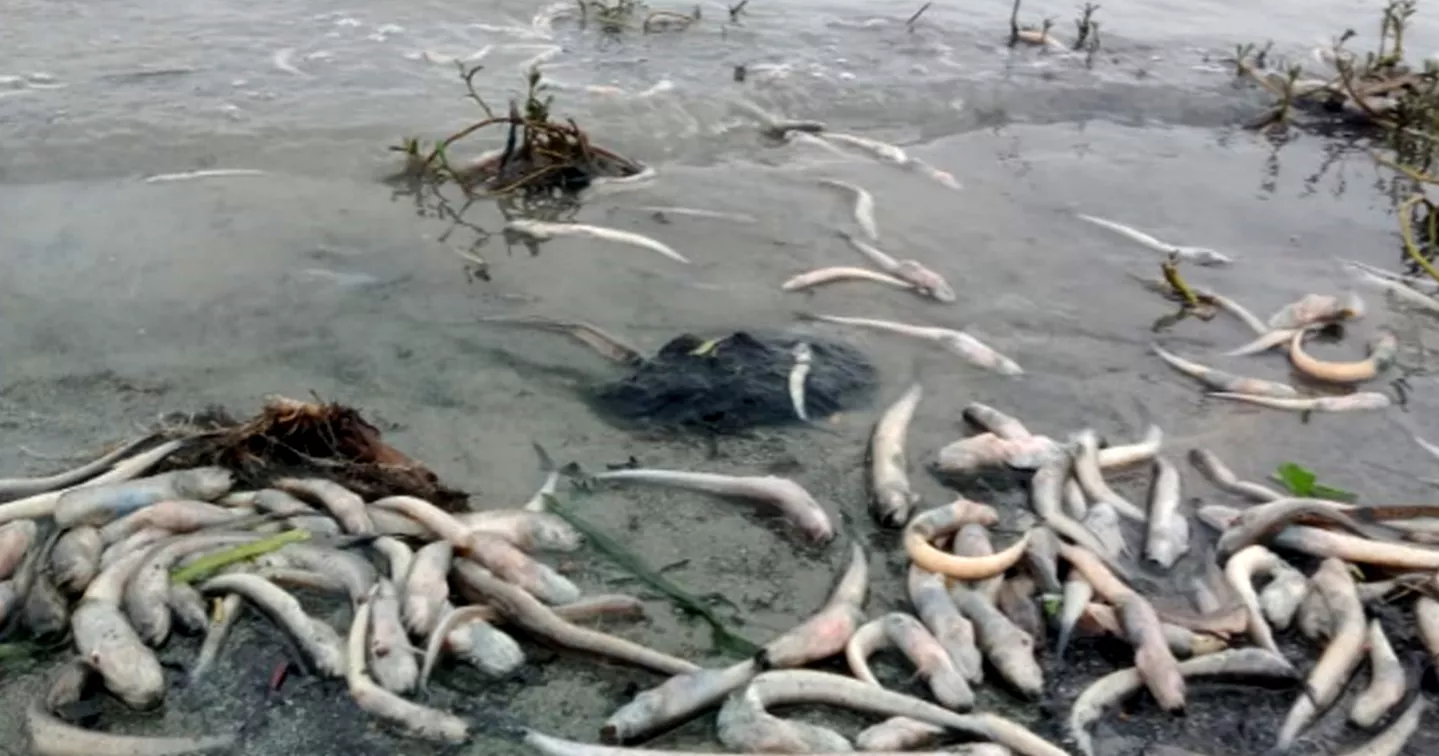The tranquil waters of the mighty Meghna River, once a lifeline for countless fishing communities, turned grim as hundreds of dead fish began surfacing along its banks from Shatnol to Dashani in Matlab Uttar upazila.
The sudden die-off of various indigenous species has raised concern and sorrow among local fishermen and riverside communities, with many fearing yet another environmental disaster, reports UNB.
An on-spot visit on Friday revealed that the stench of decaying fish now hangs heavy in the air as the once-pristine river, a lifeline for thousands, bears the scars of pollution and neglect.
Locals claimed that the unchecked discharge of toxic industrial waste and chemically contaminated water continues to poison the Meghna, rendering it unfit for both human use and aquatic life.
According to the Department of Environment (DoE) in Chandpur, similar instances of mass fishery mortality was investigated earlier in January of this year due to water pollution.
The recurrence of such incidents has led to calls for fresh inquiries and immediate intervention.
During the field visit, the devastation was all too evident. Shoals of dead fish, including jatka (premature hilsa), chewa, bele, tengra, puti, and chapila, were seen drifting lifelessly near the banks.
The pungent odour of decomposing fish has made life unbearable for the locals living nearby as many complain that the river water – once a daily necessity – has now become hazardous to even touch, let alone consume.
Matlab Uttar’s Senior Fisheries Officer Bijoy Kumar Das, said, “This is no ordinary fish death – it’s an ecological disaster. Polluted water from Narayanganj’s Shitalakkhya River has repeatedly wreaked havoc here.” Similar incidents were recorded in March 2023 and August 2024.
“This time, the scale seems greater,” he warned.
Local fishermen, who ventured out early in the morning, were the first to discover the tragedy.
Palash Barman and his brother, fisherman from Shatnol, said, “This river is our life. But it’s no longer teeming with fish; it’s laced with poison. This has been happening for years, and no effective action is ever taken. If this continues, the river will be emptied of all life.”
For the communities whose lives are entwined with the river, the floating carcasses of jatka and tengra are not just signs of ecological decay, but grim symbols of livelihoods slipping away.
The implications are severe, particularly for the future of hilsa, Bangladesh’s national fish. The mass death of Jatka has sent ripples of concern through the fishing community.
“If the young hilsa continue to perish like this, there may be no hilsa to catch during the main season,” lamented one worried fisherman.
Dashani resident Selina Begum expressed deep concern over health risks, especially for children, mentioning, “our children used to bathe and play in this river. Now, even touching the water feels dangerous. It could cause rashes or infections. We used to drink and use this water but we cannot anymore.”
Fish trader Rafiqul Islam from the same area also fears a prolonged scarcity. “What I’ve seen today makes it clear – fish will be scarce in the market for the coming months. Prices will skyrocket, and the locals will suffer.”
Mohammad Shamsuddin, a member of Kolakanda Union Parishad, voiced his dismay as well.
He said, “I have visited the affected areas. This is not just an environmental catastrophe – it’s a direct blow to human lives and livelihoods.”
Emphasising the river’s vital role in the lives of hundreds, the Union Parishad member said, “Repeated complaints have been made, but no effective action has been taken. I am preparing to raise the issue at the Upazila Parishad and will also file a written complaint with the district administration. Saving the river must now become our collective cause.”
Social organisation, Matlober Mati O Manush, also condemned the situation. Its president, Shamim Khan, said, “Thousands of families depend on this river for fishing. Repeated pollution has turned the Meghna into a dying river. But the authorities remain apathetic.”
He mentioned that they urgently need an inter-district environmental commission and punitive action against factories polluting the waters. “This is not just an ecological loss – it’s a humanitarian and economic disaster. Hundreds of fishermen and traders are now facing existential threats,” he added.
Md Mizanur Rahman, DoE deputy director in Chandpur, acknowledged the situation, saying, “This year on January 30, a high-level investigation team from the DoE and the Department of Fisheries visited the site. The findings indicated elevated ammonia levels, decreased pH and oxygen content, and toxic effluents flowing along the riverbed from industrial sources.
“We need to investigate why this is happening again. As of now, we’ve received no fresh official complaints. A site visit will reveal the extent of the damage,” he assured.
As the Meghna’s waters continue to flow past the riverine villages of Matlab Uttar, they carry with them more than just silt and current – they bear the weight of uncertainty.


